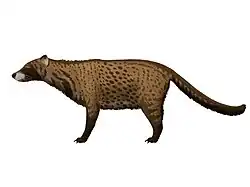Vishnuictis
| Vishnuictis Temporal range: Miocene–Pleistocene,
| |
|---|---|

| |
| Life restoration | |
| Scientific classification | |
| Kingdom: | Animalia |
| Phylum: | Chordata |
| Class: | Mammalia |
| Order: | Carnivora |
| Suborder: | Feliformia |
| Family: | Viverridae |
| Subfamily: | Viverrinae |
| Genus: | † Pilgrim, 1932 |
| Type species | |
| †Vishnuictis durandi (Lydekker, 1884)
| |
| Species[1][2][3] | |
| |
| Synonyms | |
|
Vishnuictis chinjiensis
Vishnuictis durandi
| |
Vishnuictis is an extinct genus of viverrid known from the Middle Miocene to Pleistocene of India, Pakistan, China, Myanmar, and Kenya.[1] It is named after Vishnu, one of the primary Hindu deities, with the Greek word ἴκτις (ίktis) "marten".
Description
The holotype of V. durandi was discovered by W. E. Baker and M. K. Durand in the year 1836 from the Himalayan region.[4]. In 1868, Hugh Falconer had conducted research on the fossils and described it as possible new unnamed species of Canis. In 1884, Richard Lydekker also conducted the research on the specimen but described it as a type of viverrinae and described it as Viverra durandi, where the species name is after H. M. Durand, who discovered the fossils. In 1932, Pilgrim as also conducted a detailed research of the specimen and found out that it is quite distinguishable from the genus Viverra and described it as a species of the new genus Vishnuictis. [1] V. durandi and V. salmontanus are known from multiple skulls described as overall being extremely high and slender.[1] Other species are known from multiple teeth and mandible fragments.[1][2][3] Specimens of V. plectilodous suggest a possibly omnivorous diet and a body size larger than previously thought.[3]
Distribution
The oldest known fossil record of Vishnuictis is V. africana (named after the continent of Africa) from the Muruyur Formation of Kenya, which date to the Middle Miocene.[5] In Asia, V. salmontanus has been reported from the Dhok Pathan Formation and the Yuanmou Formation (China).[1] V. plectilodous (India) and V. hasnoti (Pakistan) are also known from Dhok Pathan Formation outcrops.[3] V. hariensis is known from Late Miocene Nagri Formation (India).[6] V.? chinjiensis is reported from the Middle Miocene Chinji Formation of both India and Pakistan and is the oldest known Asian species of the genus. The species V.? durandi and V. hinduensis have been reported from the Pliocene to Pleistocene Pinjor Formation (India).[1]
Taxonomy
V. durandi and V. chinjiensis were originally assigned to the genusViverra.[1] The species V. hasnoti is closely related to V. plectilodous.[3]
References
- ^ a b c d e f g h Pilgrim, G. (1932). "The fossil Carnivora of India". Palaeontologia Indica, Memoirs of the Geological Survey of India. 18: 206–209.
- ^ a b Dong, Wei; Liu, Jianhui; Pan, Yuerong (2003). "A new Euprox from the Late Miocene of Yuanmou, Yunnan Province, China, with interpretation of its paleoenvironment" (PDF). Chinese Science Bulletin. 48 (5): 485. Bibcode:2003ChSBu..48..485D. doi:10.1007/BF03183257.
- ^ a b c d e Sankhyan, Anek Ram; Abbas, Sayyed Ghyour; Jasinski, Steven E.; Khan, Muhammad Akbar; Mahmood, Khalid (2025-03-22). "Rare carnivorous mammals from a diverse fossil assemblage from the Middle Siwaliks of Haritalyangar area, Himachal Pradesh, North India". Journal of Mammalian Evolution. 32 (2): 14. doi:10.1007/s10914-025-09749-4. ISSN 1573-7055.
- ^ Baker, W.E.; Durand, H.M. (1836). Fossil remains of the smaller Carnivora from the Sub-Himalayas. Journal of the Asiatic Society of Bengal. 5: 579—584.
- ^ Werdelin, Lars; Peigné, Stéphane (2010). Cenozoic Mammals of Africa. University of California Press. p. 624. doi:10.1525/california/9780520257214.001.0001.
- ^ Prasad, K.N (1968). The vertebrate fauna from the Siwalik beds of Haritalyangar, Himachal Pradesh, India. Vol. 39. Manager of Publications.
General references
- Morales, Jorge; Pickford, Martin (2008). "Creodonts and carnivores from the Middle Miocene Muruyur Formation, Kipsaraman and Cheparawa, Baringo District, Kenya". Comptes Rendus Palevol. 7 (8): 487. Bibcode:2008CRPal...7..487M. doi:10.1016/j.crpv.2008.09.011.
- R., Carroll (1998). "R. L. Carroll. 1988. Vertebrate Paleontology and Evolution" (PDF). Sivalik Hills Fauna. doi:10.2307/3514548. JSTOR 3514548. S2CID 86406076.
- Dong, Wei; Qi, Guoqi (2013). "Hominoid-Producing Localities and Biostratigraphy in Yunnan". Fossil Mammals of Asia-Neogene Biostratigraphy and Chronology: 293–313. doi:10.7312/columbia/9780231150125.003.0011. ISBN 978-0-231-15012-5.